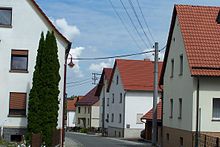Völkershausen mountain range
The event, noted worldwide as the Völkershausen mountain strike, was a disaster caused by mining activities . It resulted in the extensive destruction of the Rhön community of Völkershausen and occurred on March 13, 1989 at around 2:02 p.m.
event
A scheduled demolition in the pit of the GDR potash mining company Ernst Thälmann led underground to a large-scale collapse of a mining field and at the same time on the surface to an earthquake with a magnitude of M L = 5.6 on the Richter scale . Almost 80% of the 360 residential buildings in the village were damaged. Almost all historical buildings, the castle with its outbuildings, the church, the rectory and 15 private houses had to be demolished. In the post-reunification period, the region received 36 million Deutschmarks to repair damage. In today's place, information boards are set up at prominent points, which remind of the history of the respective building. According to the investigation committee, only six people were injured in the twelve-second quake.
rating
The rockfall near Völkershausen is one of the most energetic seismic events in the world that were triggered by mining activities. Around 3200 pillars made of carnallite , five to ten meters high and about 30 m wide , collapsed in a short time. The ground vibrations caused by the rockfall were felt up to a distance of more than 300 km, they reached the local magnitude M L = 5.6. According to rough calculations, the released energy of this mountain range corresponded to 200,000 tons of TNT . 850 m higher in Völkershausen, the ground sank in places by more than a meter. The seismic tremors were noticeable as far as Berlin, Hanover, Nuremberg, Frankfurt, Cologne and Ingolstadt, and observations were even reported from Prague and Vienna.
causes
The rockfall was probably caused by calculation errors in the dimensioning of the necessary supporting pillars in the mining field, apparently combined with an underground gas eruption triggered by the scheduled blasting in the Merkers potash pit, which caused the required statics of the mining field to collapse in an impulse-like manner over an area of 6.8 square kilometers.
consequences
The direct consequences of the rockfall were damage amounting to 40.5 million GDR marks for the repair of the damage, the construction of new buildings, insurance values and other forms of compensation. Large parts of the historic buildings were badly damaged and had to be removed, including Völkershausen Castle and St. Anne's Church , built in the early 18th century .
At the suggestion of the SED district management in Suhl, the reconstruction and repair of the buildings began immediately and unbureaucratically. Two blocks of flats, the day care center, a department store and around 50 private homes were immediately rebuilt. The goal was to finish the work by the 40th anniversary of the GDR in autumn 1989. Politburo member Werner Jarowinsky and other high-ranking SED functionaries visited the miners' places. The distribution of material benefits and the simultaneous discipline by the State Security had an impact in the May 1989 election. Reconstruction, which began quickly, evidently created confidence and trust in the population.
Shortly after the rockfall, the slopes of the Schönbrunn Dam , which is about 65 km from the epicenter, were subjected to an in-depth investigation. The investigations were carried out by a commission of experts, as there are active hangar areas in the reservoir of the dam , which under certain circumstances can be reactivated by seismic activities.
literature
- Günter Leydecker (ed.): The rockfall of March 13, 1989 near Völkershausen in Thuringia in the potash mining area of the Werra Valley, Geological Yearbook Series E, Volume E 55, E. Schweizerbart, Stuttgart 1998
- Günter Leydecker, Gottfried Grünthal and Ludwig Ahorner : The rockfall of March 13, 1989 near Völkershausen in Thuringia in the potash mining area of the Werra Valley . E. Schweizerbart'sche Verlagbuchhandlung, Stuttgart 2009.
- Eike Kellermann: The Völkershausen rockfall on March 13, 1989 . In: Thr. State Center for Political Education (Ed.): Sheets on regional studies . Erfurt 2003, p. 8 .
Individual evidence
- ^ News (Thuringian Rhön) . In: Rhönklub (Ed.): Rhönwacht . No. 1 , 1995, ISSN 0936-1723 , pp. 40 .
- ↑ Dispute over guilt for the earthquake. voelkershausen.de, accessed on March 10, 2009 .
- ↑ a b Quake became a political issue. stz-online.de, March 14, 2008, archived from the original on June 14, 2009 ; Retrieved October 26, 2012 .
- ↑ Eike Kellermann: The mountain fall of Völkershausen on March 13, 1989 . In: Thr. State Center for Political Education (Ed.): Sheets on regional studies . Erfurt 2003, p. 8 .




